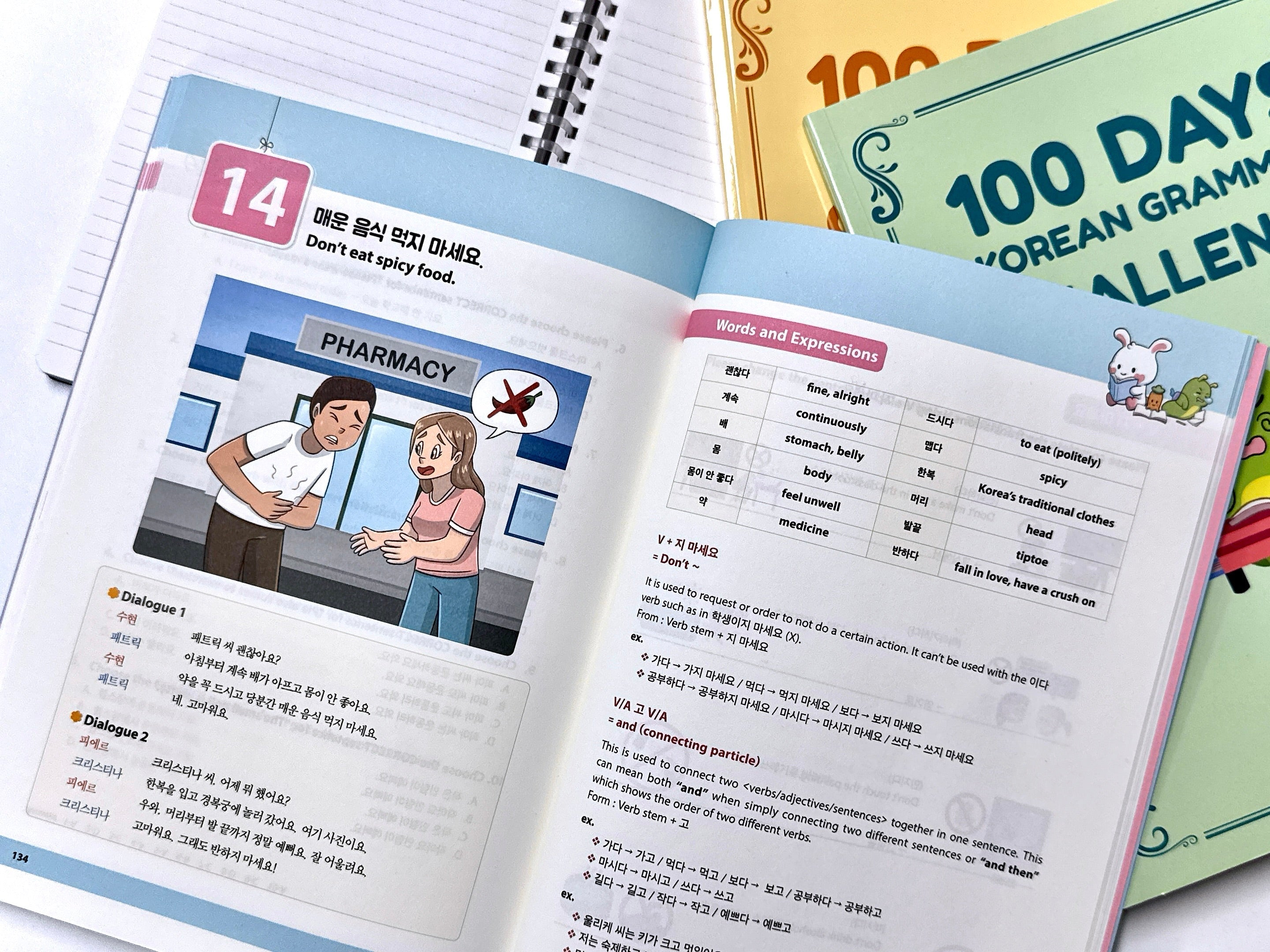Korean For All 1 Chapter 14: V+ 지마세요, Connecting with -고 in Korean

How to Politely Say “Don’t” in Korean – Mastering 지 마세요 & -고!
Welcome to Lesson 14! 🎉 We’re almost done with the book—amazing work so far!
Today, we’ll learn some super practical grammar points that will help you in everyday conversations.
Today’s lesson includes:
✅ How to say “Don’t do that” politely using 지 마세요
✅ How to connect actions smoothly using -고
✅ Important vocabulary for health, body parts, and daily life
✅ A look into Korean traditional clothing (Hanbok) & houses (Hanok)!
1. Essential Vocabulary – Health & Everyday Life
Before we jump into grammar, here are some useful words from today’s lesson!
| English | Korean | Pronunciation |
|---|---|---|
| Fine/Okay | 괜찮다 | gwaenchanhda |
| Continuously | 계속 | gyesok |
| Stomach/Belly | 배 | bae |
| Body | 몸 | mom |
| To feel unwell | 몸이 안 좋다 | momi an jota |
| Medicine | 약 | yak |
| To eat (polite) | 드시다 | deusida |
| Spicy | 맵다 | maepda |
| Hanbok (traditional clothes) | 한복 | hanbok |
| To fall in love | 반하다 | banhada |
📌 Useful Expressions:
- “배가 아파요.” (My stomach hurts.)
- “몸이 안 좋아요.” (I don’t feel well.)
- “약을 먹어야 해요.” (I need to take medicine.)
2. Grammar Spotlight: How to Say “Don’t” (V + 지 마세요)
Want to politely tell someone not to do something? Use 지 마세요!
✔ Take the verb stem and add 지 마세요
✔ It means “Please don’t ~.”
Examples:
- 가다 (to go) → 가지 마세요 (Please don’t go.)
- 먹다 (to eat) → 먹지 마세요 (Please don’t eat.)
- 보다 (to see) → 보지 마세요 (Please don’t look.)
- 공부하다 (to study) → 공부하지 마세요 (Please don’t study.)
- 마시다 (to drink) → 마시지 마세요 (Please don’t drink.)
🎯 Practice: Try making sentences using 지 마세요!
3. Grammar Spotlight: Connecting Actions with -고 (and, then)
Use -고 to smoothly connect verbs or adjectives—it’s like saying “and” in English!
✔ Take the verb/adjective stem and add -고
Examples with Verbs:
- 가다 (to go) → 가고 (Go and…)
- 먹다 (to eat) → 먹고 (Eat and…)
- 공부하다 (to study) → 공부하고 (Study and…)
Examples with Adjectives:
- 길다 (to be long) → 길고 (Long and…)
- 작다 (to be small) → 작고 (Small and…)
- 예쁘다 (to be pretty) → 예쁘고 (Pretty and…)
Putting it into Sentences:
- “울리케 씨는 키가 크고 멋있어요.” (Ulrike is tall and cool.)
- “저는 숙제하고, 낸시 씨는 운동해요.” (I do homework, and Nancy works out.)
- “먹고 학교에 가요.” (I eat and then go to school.)
🎯 Practice: Try making two connected sentences using -고!
4. K-Culture Corner – Hanbok & Hanok!
1. 한복 (Hanbok) – Korea’s Traditional Clothing
Hanbok is Korea’s traditional attire that has been worn for over a thousand years!
✔ For men: The 저고리 (jeogori, upper jacket) and 바지 (baji, pants).
✔ For women: The 저고리 (jeogori) and 치마 (chima, skirt).
💡 TIP: You can rent a Hanbok in places like Gyeongbokgung Palace for a fun experience!
2. 한옥 (Hanok) – Traditional Korean Houses
Hanoks date back to the Joseon Dynasty (14th century)!
✔ Built with eco-friendly materials (wood, soil, stone).
✔ Features 온돌 (ondol) heated floors for winter.
✔ Popular spots: Bukchon Hanok Village (Seoul), Jeonju Hanok Village, Andong Hahoe Village.
📌 Fun Idea: Rent a Hanbok while visiting a Hanok village for the perfect historical experience!
5. Your Homework!
1️⃣ Write three sentences using 지 마세요 to tell someone not to do something.
2️⃣ Practice using -고 to connect two actions.
3️⃣Complete exercises on pages 136-138 in your textbook.
4️⃣ Watch a Korean drama and listen for 지 마세요 in conversations!
-
Posted in
korean grammar, level 1


